Risotto, a cornerstone of Italian cuisine, often appears shrouded in culinary mystery. With its creamy texture and rich flavors, this beloved dish has won the hearts of food lovers globally. In our journey of making risotto, we'll highlight its intricacies, offering key tips and answering common questions. Whether you're a novice or a seasoned cook, these insights will guide you to perfecting this classic, turning simple ingredients into an extraordinary meal. Let's embark on this delicious adventure, one stir at a time!

Italian recipes are renowned for emphasizing fresh, high-quality ingredients, and risotto is no exception. Whether preparing a classic saffron risotto or experimenting with other variations, the principles of risotto-making remain the same. Patience, attention to detail, and a willingness to embrace the simplicity and richness of Italian cooking are key.
Jump to:
The trick to perfect risotto
So, what's the trick to risotto? It combines choosing the proper rice and mastering the art of stirring. Arborio or Carnaroli rice, both short-grain rice varieties, are ideal due to their high starch content, which is critical to achieving that creamy texture.
The constant stirring isn't just a workout for your arms; it creates essential friction without broth excess, releasing the starch from the grains. This process transforms a simple rice bowl into a creamy, luxurious risotto.
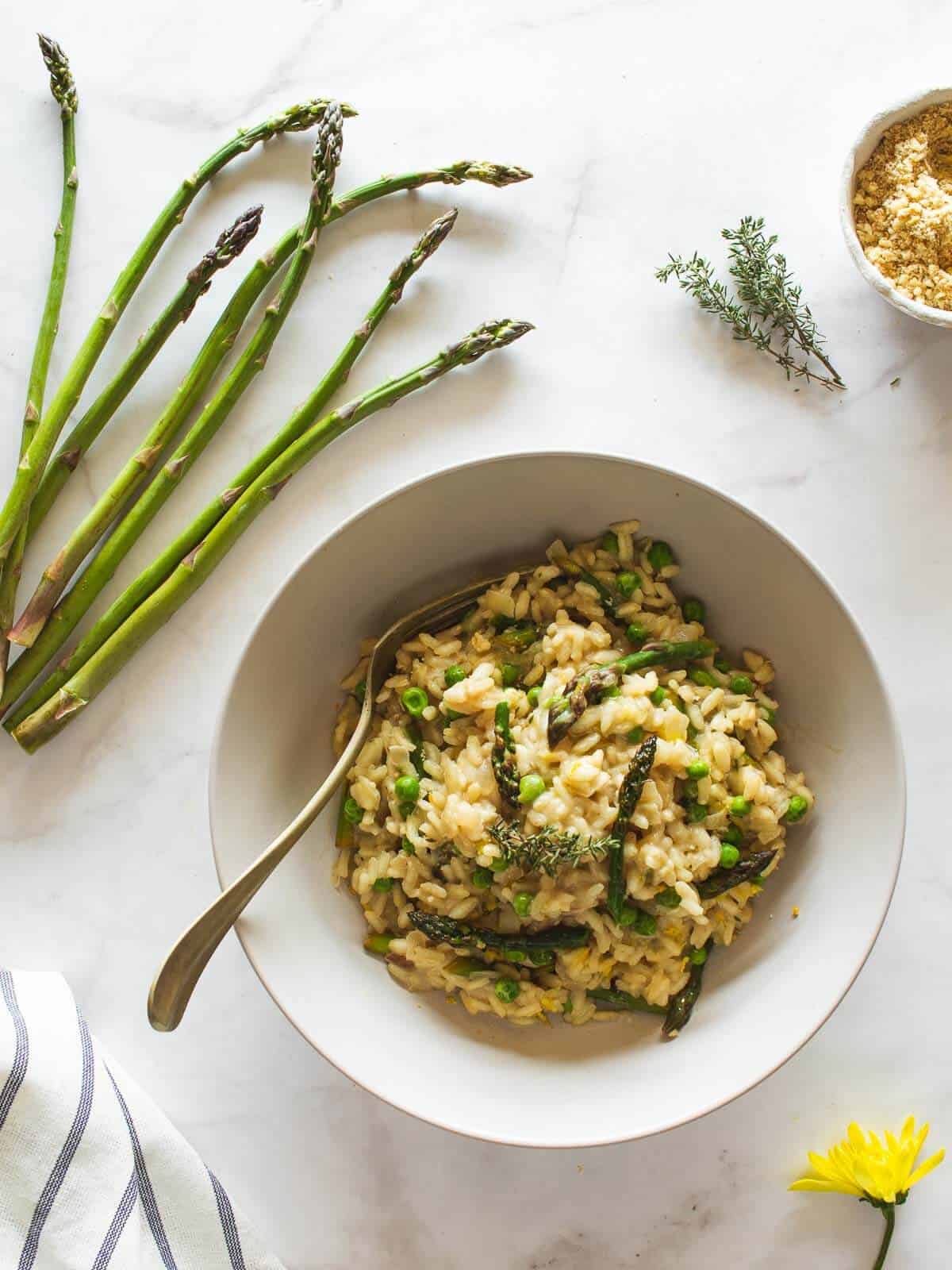
Simplicity behind sophistication
Many people ask me if risotto is a hard dish to make. While it has a reputation for being temperamental, risotto is quite approachable. The key is not complexity but consistency. You must be present, stirring and nurturing the dish, ensuring even cooking and the perfect release of starch. It's a simple process, but it requires your undivided attention.
Timing and technique
Cooking a proper risotto requires about 20 to 25 minutes, varying with the rice type and age. This duration is essential for the grains to gradually absorb the stock, resulting in each grain being perfectly cooked. Patience is indeed a vital ingredient in this process.
The slow dance
You may ask, why does risotto have to be cooked slowly? This slow cooking process is not about testing your patience but ensuring each grain of rice is perfectly al dente. Adding the stock gradually prevents the grains from floating and ensures they rub against each other, crucial for releasing starch and achieving that signature creamy texture.

Hint: only add more stock when the previous ladle has dried out. Keep adding about ⅓ cup at a time.
The stirring saga
Stirring risotto during cooking is crucial. It ensures even heat distribution, allowing the rice to cook uniformly. This action also prevents the grains from sticking and burning at the bottom of the pan. Continuous stirring and avoiding clumps are the keys to a creamy, smooth risotto.
The softening of the rice is a gradual process. This time allows the rice to slowly absorb the flavors of the stock and other ingredients, resulting in a dish rich in flavor and perfect in texture.
The four pillars of risotto cooking
What are the four stages of cooking risotto? These stages are crucial for a successful dish:
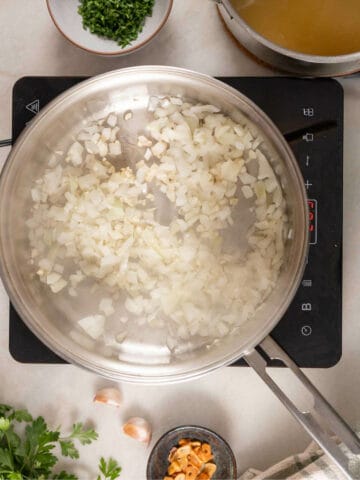
Pillar 1: Sauté Onions - This first step lays the flavor foundation.

Pillar 2: Toast the Rice - Toasting the rice in oil coats each grain, which helps maintain texture throughout cooking.
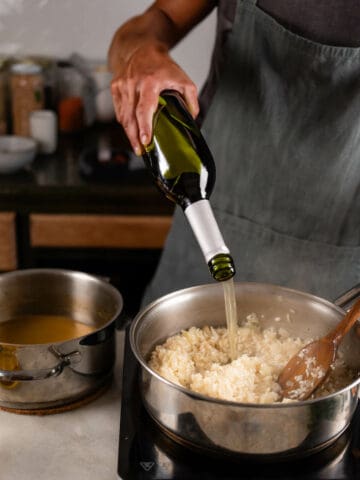
Pillar 3: Deglaze with Wine - The acidity in the wine balances the richness and adds depth.

Pillar 4: Stock Addition & Mantecatura - Adding stock gradually allows for even cooking and creaminess. The final step, 'mantecatura,' involves stirring in butter or vegan butter for richness and a silky finish.
Risotto in restaurants
Do restaurants pre-cook rice for risotto? A common question with a surprising answer: they often don't. The beauty of risotto lies in its freshness; chefs typically cook it from scratch, which takes about 20-25 minutes. This timing might seem long, but it's perfectly aligned with the rhythm of a relaxed dining experience, especially when you're enjoying an appetizer or a glass of wine, which, by the way, is needed to deglaze the risotto: one for a glass for the dish, and why not? treat yourself to a glass while making dinner.
Pre-cooking risotto?
How do you precook risotto like a restaurant? In truth, most chefs prefer to cook risotto from scratch for each order. However, if you need to save time, you can partially cook the risotto and finish it just before serving.
This method involves cooking the risotto until it's halfway done, then spreading it on a tray to cool quickly. When it's time to serve, reheat the risotto with some additional stock and finish it as usual.
Troubleshooting
Why does my risotto taste hard? Encountering a hard texture in your risotto can be disheartening, but it's often a fixable issue. The key lies in the balance of heat, liquid, and cooking time. If your risotto isn't as tender as you'd like, consider these factors:
Heat and Liquid Balance: Cooking risotto is a delicate dance between heat and moisture. If the heat is too high, the liquid may evaporate too quickly, preventing the rice from absorbing enough to become tender. On the other hand, too little heat can result in an uneven cook. The trick is maintaining a gentle simmer, ensuring the rice cooks evenly and absorbs the liquid quickly.
Rice Quality and Type: The choice of rice is crucial. Arborio or Carnaroli rice is preferred for absorbing liquid while maintaining a firm texture. Ensure your rice is fresh; older rice might have lost its optimal moisture-absorbing properties. This is where the expiration date comes into play.
Always check the packaging date to ensure the rice is within its best-use period. Fresh rice absorbs the liquid more effectively, creating a creamier risotto.
By addressing these aspects, you can transform a hard risotto into a creamy, delightful dish that perfectly embodies the essence of Italian cooking.
Great recipes
Also, try our vegan asparagus risotto, vegan butternut squash risotto, sun-dried tomato risotto, red wine risotto, and winter risotto.
In conclusion
Risotto is more than just a dish; it's a culinary journey that rewards patience and attention. Understanding its nuances and respecting the process can transform simple ingredients into a symphony of flavors and textures. So embrace the stir, enjoy the process, and prepare to serve a bowl of creamy, dreamy risotto.
FAQs
Traditionally, risotto is made with specific types of rice like Arborio, Carnaroli, or Vialone Nano. These varieties are high in amylopectin, a type of starch that contributes to the creamy texture of a classic risotto.
Now, if you're eyeing that bag of regular rice in your pantry and wondering if it can transform into a delightful risotto, here's the scoop: Regular rice, like long-grain varieties, typically has less amylopectin compared to Arborio or Carnaroli. This means that while you can technically make a risotto-like dish with regular rice, it might not achieve the same level of creaminess.
However, don't let this discourage you! You can still whip up a delicious, risotto-esque dish with regular rice. It's all about the cooking technique. Slowly cooking the rice while adding liquid and stirring frequently can help release the available starches, creating a somewhat creamy texture. It won't be exactly like traditional risotto but can still be a tasty and satisfying dish.
Yes, it is not only possible but also quite simple. The key to a great risotto is gradually adding liquid and constant stirring to release the starches from the rice, creating that signature creamy texture.
Traditionally, risotto recipes often include white wine for its acidity and depth of flavor. However, if you prefer not to use wine, you can use vegetable broth alone.
As the lead content writer and recipe developer at Our Plant-Based World, he combines his passion for health and sustainability with a Plant-Based Nutrition Certification to create accessible, delicious vegan recipes. His expertise in plant-based cooking supports the blog's mission of fostering a healthier, environmentally conscious lifestyle through simple and seasonal dishes. His commitment to making vegan cooking enjoyable and inclusive for everyone shines in each recipe and article.


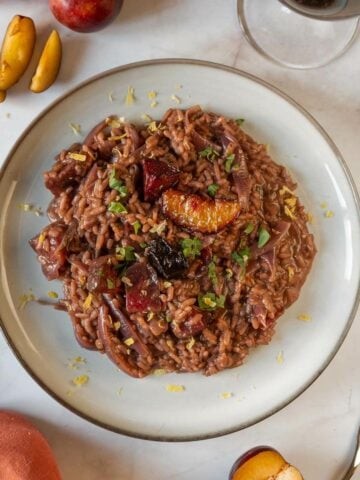
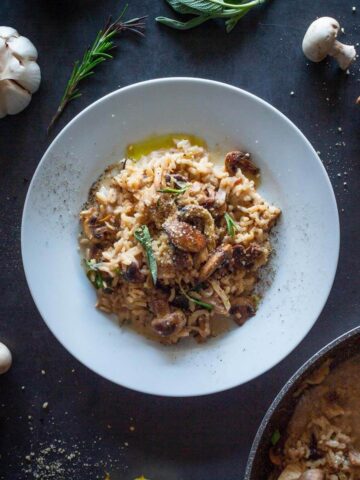

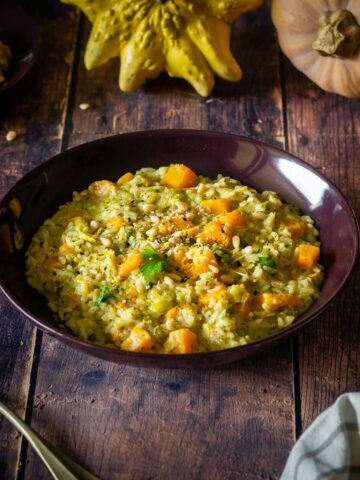

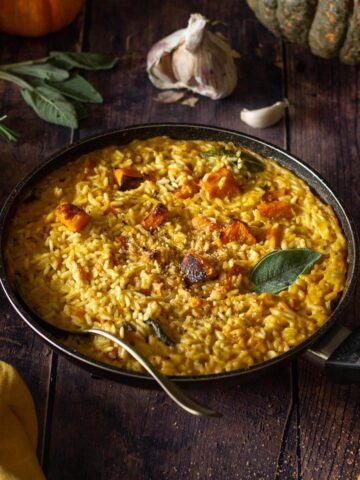
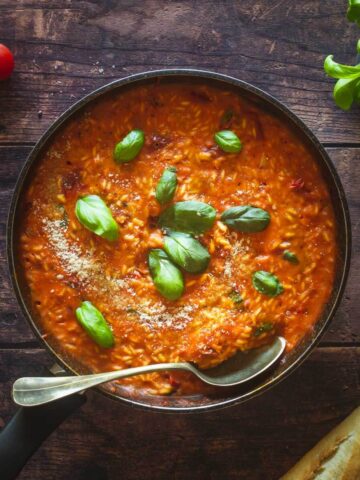



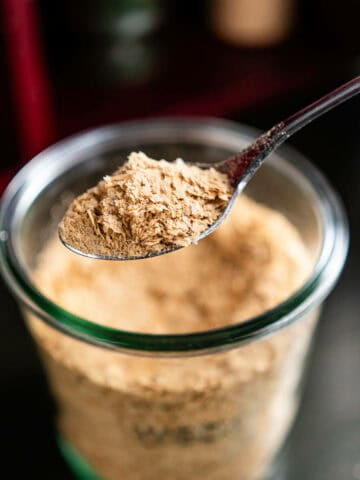

Gianne
The step-by-step instructions are easy to follow, and the result is a creamy and flavorful risotto that will impress even the most discerning foodie.
Nathan
I've always been a little intimidated by risotto, but this post broke it down and made it much easier and less difficult! Can't wait to give one a try, that red wine risotto looks particularly delicious 🙂
Gustavo De Obaldia
Hey Nathan! That's awesome to hear! Risotto can seem a bit tricky, but once you get the hang of it, it's a game-changer. Red wine risotto is a tasty choice – it's like a flavor explosion in your mouth! Give it a shot, and don't hesitate to ask if you've got any questions.
Kim
I especially love the tip about pre-cooking. This is such a game-changer! Thanks for sharing.
Casey
These are great tips! Looking forward to putting them to good use next week with chicken dinner!
Chenee
Thanks for the great tips! Risotto is one of my favorite dishes but it can be temperamental!